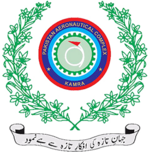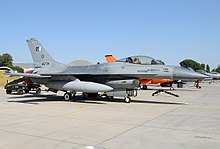
The Dassault Mirage III is a family of single/dual-seat, single-engine, fighter aircraft developed and manufactured by French aircraft company Dassault Aviation. It was the first Western European combat aircraft to exceed Mach 2 in horizontal flight, a feat which was achieved on 24 October 1958.
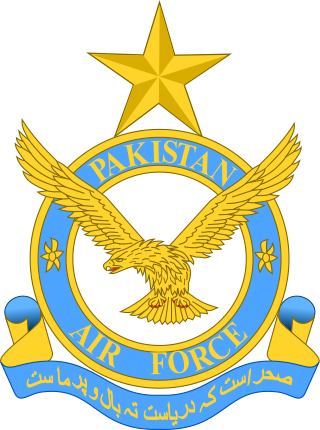
The Pakistan Air Force (PAF) is the aerial warfare branch of the Pakistan Armed Forces, tasked primarily with the aerial defence of Pakistan, with a secondary role of providing air support to the Pakistan Army and Pakistan Navy when required, and a tertiary role of providing strategic airlift capability to Pakistan. As of 2021, as per the International Institute for Strategic Studies, the PAF has more than 70,000 active-duty personnel and operates at least 1370+ aircraft.PAF stands as the eight largest Air Force in the world. PAF is the largest Air Force of the Muslim world in terms of aircraft fleet. Its primary mandate and mission is "to provide, in synergy with other inter-services, the most efficient, assured and cost effective aerial defence of Pakistan." Since its establishment in 1947, the PAF has been involved in various combat operations, providing aerial support to the operations and relief efforts of the Pakistani military. Under Article 243, the Constitution of Pakistan appoints the President of Pakistan as the civilian Commander-in-Chief of the Pakistan Armed Forces. The Chief of the Air Staff (CAS), by statute a four-star air officer, is appointed by the President with the consultation and confirmation needed from the Prime Minister of Pakistan.

The Hongdu JL-8, also known as the Karakorum-8 or K-8 for short, is a two-seat intermediate jet trainer and light attack aircraft designed in the People's Republic of China by China Nanchang Aircraft Manufacturing Corporation. The primary contractor is the Hongdu Aviation Industry Corporation.

The Dassault Mirage 2000 is a French multirole, single-engine, fourth-generation jet fighter manufactured by Dassault Aviation. It was designed in the late 1970s as a lightweight fighter to replace the Mirage III for the French Air Force. The Mirage 2000 evolved into a multirole aircraft with several variants developed, with sales to a number of nations. It was later developed into the Mirage 2000N and 2000D strike variants, the improved Mirage 2000-5, and several export variants. Over 600 aircraft were built and it has been in service with nine nations.

The Dassault Mirage 5 is a French supersonic attack aircraft designed by Dassault Aviation during the 1960s and manufactured in France and a number of other countries. It was derived from Dassault's popular Mirage III fighter and spawned several variants of its own, including the IAI Kfir. In Pakistan's service, the Mirage 5s are modified and are capable of nuclear weapons delivery.

The Chengdu J-10 Vigorous Dragon, is a medium-weight, single-engine, multirole combat aircraft capable of all-weather operations, configured with a delta wing and canard design, with fly-by-wire flight controls, and produced by the Chengdu Aircraft Corporation (CAC) for the People's Liberation Army Air Force (PLAAF), Pakistan Air Force (PAF) and People's Liberation Army Naval Air Force (PLANAF). The J-10 is mainly designed for air-to-air combat, but can also perform strike missions.

The CAC/PAC JF-17 Thunder, or FC-1 Xiaolong, is a lightweight, single-engine, multirole combat aircraft developed jointly by the Pakistan Aeronautical Complex (PAC) and Chengdu Aircraft Corporation (CAC) of China. It was designed and developed as a fourth-generation replacement for the third-generation A-5C, F-7P/PG, Mirage III, and Mirage V combat aircraft in the Pakistan Air Force (PAF). The JF-17 can be used for multiple roles, including interception, ground attack, anti-ship, and aerial reconnaissance. The Pakistani designation "JF-17" stands for "Joint Fighter-17", with the "Joint Fighter" denoting the joint Pakistani-Chinese development of the aircraft and the "-17" denoting that, in the PAF's vision, it is the successor to the F-16. The Chinese designation "FC-1" stands for "Fighter China-1".

The Shenyang J-11 is a twin-engine jet fighter of the People's Republic of China whose airframe is derived from the Soviet-designed Sukhoi Su-27. It is manufactured by the Shenyang Aircraft Corporation (SAC). The aircraft is operated by the People's Liberation Army Air Force (PLAAF) and the People's Liberation Army Naval Air Force (PLANAF).
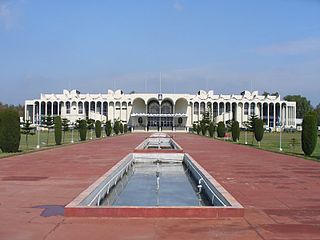
The Pakistan Air ForceAcademyAsghar Khan is an accredited three-year military academy which provides undergraduate education to officer candidates for the Pakistan Air Force.

Project ROSE was a program by the Pakistan Air Force to upgrade the avionics of its ageing Dassault Mirage III and Mirage 5 fighter jets,. These had originally been built either by Dassault Aviation in France, or by the Government Aircraft Factories (GAF) in Australia. The program, based at the Pakistan Aeronautical Complex, focused on upgrading the military avionics and onboard computer systems, with equipment supplied variously by Pakistani Margella Electronics, French SAGEM and Italian SELEX consortia.
The Defence Industry of Pakistan, established in September 1951, mainly falls under the purview of the Ministry of Defence Production (MoDP). It aims to foster collaboration and oversee the diverse range of military production facilities that have emerged since Pakistan's independence. The MoDP comprises specialized organizations, each dedicated to various aspects of the defence industry, including research and development, production, and administration.

The PAC MFI-17 Mushshak is a license-built fixed-gear basic trainer aircraft manufactured by PAC. An improved version of the Saab Safari (MFI-15), the MFI-17 is manufactured in Kamra, Pakistan, by Pakistan Aeronautical Complex (PAC). Built to Mil-Spec and fully aerobatic, it is used for training, towing and other ground support roles. An upgraded version, the PAC Super Mushshak, has also been produced by PAC.
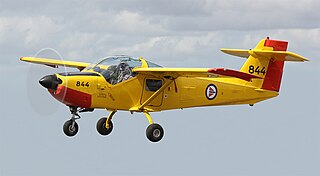
Saab MFI-15 Safari, also known as the Saab MFI-17 Supporter, is a propeller-powered basic trainer aircraft used by several air forces.

Pakistan Air Force Base, Minhas is a PAF Airbase located at Attock District, Punjab, Pakistan. It was named in the honour of Pilot Officer Rashid Minhas, who was awarded the Nishan-e-Haider for valor in the Indo-Pakistani War of 1971. Pakistan Aeronautical Complex is located in Minhas Airbase which manufactures aircraft like CAC/PAC JF-17 Thunder, PAC MFI-17 Mushshak, Hongdu JL-8. It also rebuilds aircraft like the Dassault Mirage and Chengdu F-7.Currently, PAF Base Minhas is equipped with JF-17 aircraft operated by No.16 Squadron also called "Black Panthers".
Project Sabre II was the Pakistan Air Force's program to develop a feasible and low-cost multirole combat jet based on an existing design—the Chengdu F-7 Skybolt, a Chinese variant of the MiG–21. The Pakistan Air Force (PAF) initiated Project Sabre II in 1987, hiring the American aerospace firm Grumman, to provide crucial expertise to refine the baseline aircraft design along with specialists from the PAF and the Chinese People's Liberation Army Air Force (PLAAF).
No. 7 Squadron, nicknamed the Bandits, is a tactical attack squadron of the Pakistan Air Force. Which is under the No. 32 Tactical Attack wing.

Air Headquarters (AHQ) is the Headquarters of Pakistan Air Force, located in Islamabad. Initially it was established at Peshawar on 15 August 1947. Later it was moved to Karachi on 1 June 1948 and back to Peshawar in 1960. In 1983 construction of Air headquarters was started at Islamabad after it was decided to have all the armed forces headquarters in the capital city. On 1 August 2005 the headquarters was moved from Chaklala, Rawalpindi to Islamabad. During the construction of the headquarter's building at Islamabad the headquarters directorates were housed at PAF base Chaklala.
The Grifo radar is a family of airborne radars developed by Italian firm Leonardo S.p.A. for fighter aircraft and attack aircraft, and this family of radars includes several series.
